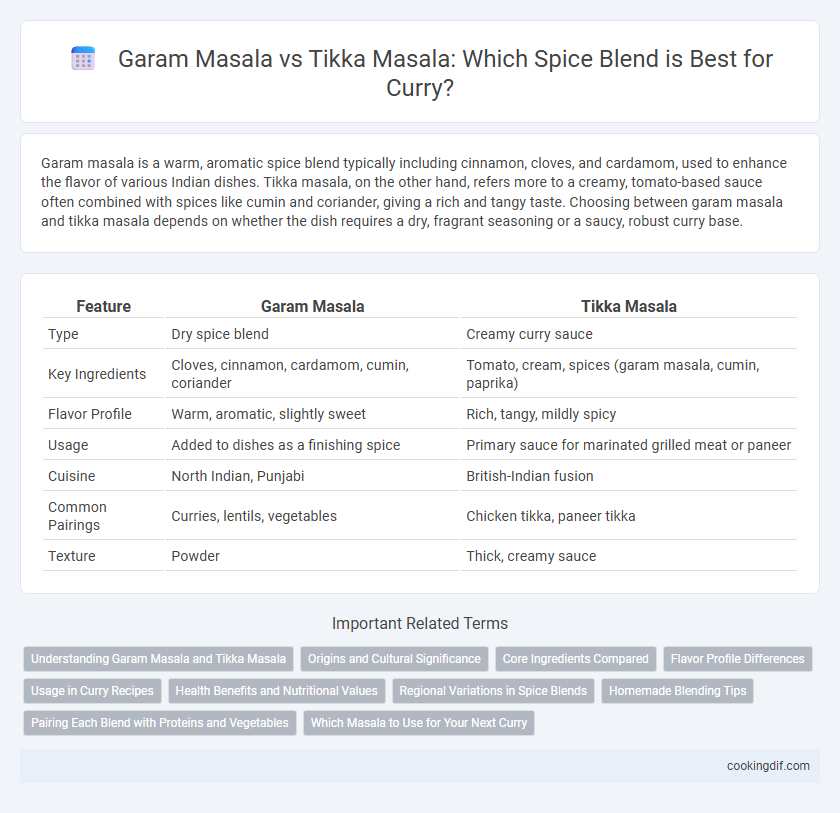Garam masala is a warm, aromatic spice blend typically including cinnamon, cloves, and cardamom, used to enhance the flavor of various Indian dishes. Tikka masala, on the other hand, refers more to a creamy, tomato-based sauce often combined with spices like cumin and coriander, giving a rich and tangy taste. Choosing between garam masala and tikka masala depends on whether the dish requires a dry, fragrant seasoning or a saucy, robust curry base.
Table of Comparison
| Feature | Garam Masala | Tikka Masala |
|---|---|---|
| Type | Dry spice blend | Creamy curry sauce |
| Key Ingredients | Cloves, cinnamon, cardamom, cumin, coriander | Tomato, cream, spices (garam masala, cumin, paprika) |
| Flavor Profile | Warm, aromatic, slightly sweet | Rich, tangy, mildly spicy |
| Usage | Added to dishes as a finishing spice | Primary sauce for marinated grilled meat or paneer |
| Cuisine | North Indian, Punjabi | British-Indian fusion |
| Common Pairings | Curries, lentils, vegetables | Chicken tikka, paneer tikka |
| Texture | Powder | Thick, creamy sauce |
Understanding Garam Masala and Tikka Masala
Garam masala is a warm, aromatic spice blend typically consisting of cumin, coriander, cardamom, cinnamon, cloves, and black pepper, essential in North Indian cuisine for adding depth and complexity to dishes. Tikka masala combines spices similar to garam masala but also includes creamy tomato-based elements, creating a rich and tangy flavor profile famously used in chicken tikka masala. Understanding the distinction between these blends helps in mastering authentic curry flavors, with garam masala used more as a finishing spice and tikka masala as a marinade or sauce base.
Origins and Cultural Significance
Garam masala, a traditional North Indian spice blend, originates from Mughal cuisine and holds deep cultural significance in Indian cooking, symbolizing warmth and comfort. Tikka masala, on the other hand, evolved in the United Kingdom as a fusion dish reflecting South Asian and British culinary influences, with its spice blend tailored to create a rich, creamy flavor profile. Both blends highlight unique cultural narratives, with garam masala emphasizing aromatic complexity and tikka masala representing cross-cultural innovation.
Core Ingredients Compared
Garam masala typically consists of ground spices such as coriander, cumin, cardamom, cloves, cinnamon, nutmeg, and black pepper, providing a warm and aromatic flavor profile. Tikka masala spice blends often include similar core ingredients but add ingredients like paprika, turmeric, and chili powder to create a smoky and mildly spicy taste with vibrant color. The balance of spices in garam masala emphasizes warmth and complexity, while tikka masala highlights a tangy, smoky flavor suited for marinating or cooking chicken and other meats.
Flavor Profile Differences
Garam masala features a warm, aromatic blend of spices like cinnamon, cloves, and cardamom, lending a complex and earthy flavor to dishes. Tikka masala spice blend combines smoky paprika, cumin, and coriander, creating a rich, tangy, and slightly sweet taste ideal for grilled or marinated meats. The key difference lies in garam masala's warming, fragrant notes versus tikka masala's bold, smoky, and creamy flavor profile.
Usage in Curry Recipes
Garam masala and tikka masala serve distinct purposes in curry recipes, with garam masala commonly used as a warm, aromatic seasoning added toward the end of cooking to enhance overall flavor complexity. Tikka masala, on the other hand, refers to a specific blend designed for marinating meats like chicken, imparting a rich, tangy profile that forms the base for creamy tikka masala curry sauces. Understanding their unique applications helps achieve authentic taste and depth in various South Asian curry dishes.
Health Benefits and Nutritional Values
Garam masala, a blend of warming spices like cinnamon, cloves, and cardamom, offers anti-inflammatory and antioxidant properties that support digestion and immunity. Tikka masala, which combines spices such as cumin, coriander, and turmeric with a creamy tomato base, provides benefits like improved digestion and potential blood sugar regulation due to its turmeric content. Both spice blends contribute essential micronutrients, but garam masala typically has a more concentrated antioxidant profile, while tikka masala provides additional vitamins from its tomato and dairy components.
Regional Variations in Spice Blends
Garam masala and tikka masala showcase distinct regional variations in Indian spice blends, with garam masala blending warm spices like cardamom, cinnamon, and cloves predominantly in North Indian cuisine. Tikka masala features a creamy tomato-based sauce infused with a milder spice mix, popularized in Punjabi and Anglo-Indian dishes. The regional preferences highlight the diverse flavor profiles, where garam masala lends intense aroma while tikka masala offers a rich, tangy taste balance.
Homemade Blending Tips
Garam masala typically consists of warm spices like cinnamon, cardamom, cloves, cumin, and coriander, offering a deep aromatic profile ideal for finishing dishes. Tikka masala blends often incorporate paprika, turmeric, garlic, ginger, and chili powder, providing a vibrant, smoky flavor suited for marinades and sauces. When mixing at home, toast whole spices before grinding to intensify flavors, and adjust ratios based on heat preference and dish requirements.
Pairing Each Blend with Proteins and Vegetables
Garam masala pairs exceptionally well with lamb, chicken, and chickpeas, enhancing their earthy flavors with its warm blend of cinnamon, cardamom, and cloves. Tikka masala complements grilled chicken and paneer, providing a creamy tomato-based richness that balances spices like cumin and coriander. Vegetables such as roasted potatoes and spinach absorb garam masala's deep aroma, while tikka masala's tangy sauce elevates bell peppers and onions in curry dishes.
Which Masala to Use for Your Next Curry
Garam masala and tikka masala are distinct spice blends, each offering unique flavors for curries. Garam masala is a warm, aromatic mix typically containing cinnamon, cardamom, cloves, and cumin, ideal for enhancing the depth of traditional North Indian curries. Tikka masala combines spices like paprika, cumin, and coriander with cream or tomato base, making it perfect for rich, creamy chicken dishes or vegetarian curries requiring a bold, tangy flavor.
Garam masala vs Tikka masala for spice blends Infographic

 cookingdif.com
cookingdif.com